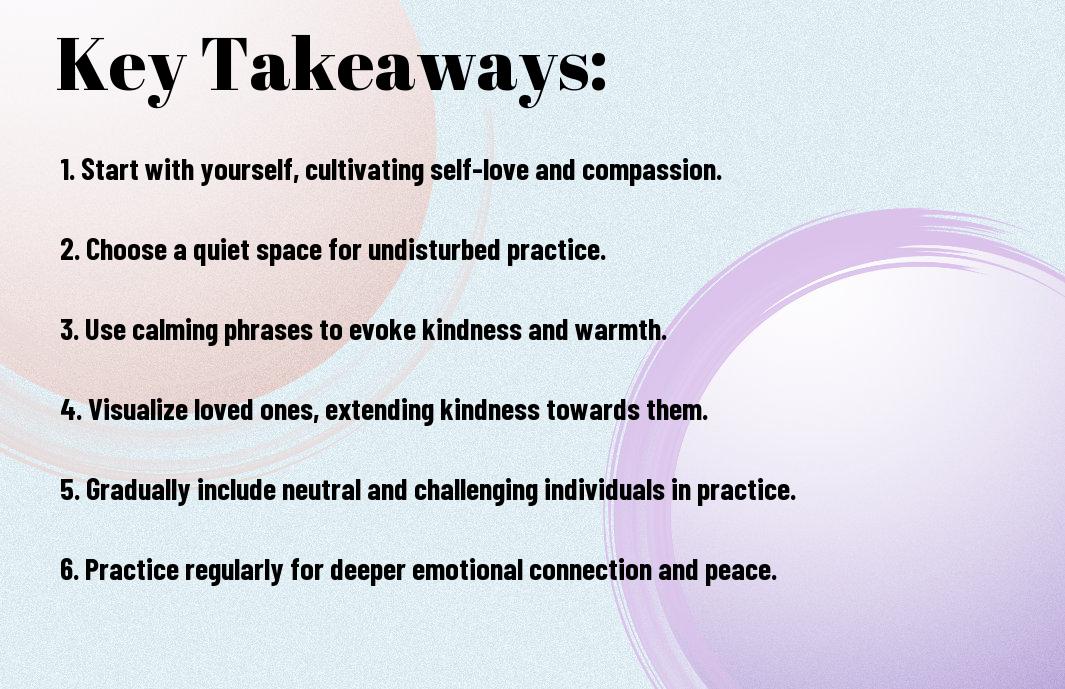There’s an abundance of ways to cultivate a daily spiritual practice that can enhance your sense of purpose and connection. By incorporating simple yet meaningful rituals into your routine, you can nurture your inner self and foster a deeper relationship with the world around you. This guide will provide you with effective strategies and suggestions to help you develop a personalized spiritual practice that resonates with your beliefs and lifestyle, creating a fulfilling path toward greater mindfulness and well-being.
Key Takeaways:
- Consistency: Establish a regular schedule for your spiritual practice to foster discipline and growth.
- Mindfulness: Engage fully in the moment, whether through meditation, prayer, or reflection, to enhance your spiritual awareness.
- Personalization: Tailor your practice to align with your beliefs, preferences, and lifestyle for a more meaningful experience.
- Variety: Incorporate diverse activities such as reading, journaling, or nature walks to enrich your spiritual journey.
- Community: Connect with others who share similar spiritual interests to gain support and inspiration in your practice.
Understanding Spiritual Practice
Your spiritual practice is a personal journey that fosters connection with your inner self, the universe, or a greater power. Engaging with the Science of Spirituality (+16 Ways to Become More Spiritual) can deepen this connection and enhance your daily experiences.
Definition and Importance
Definition of spiritual practice encompasses the actions and rituals that help you explore your spirituality, whether through meditation, prayer, or mindfulness. These practices play a vital role in cultivating self-awareness and promoting a deeper understanding of your life’s purpose.
Benefits of Daily Practice
For many, incorporating a daily spiritual practice offers numerous benefits, such as reduced stress, improved emotional health, and enhanced clarity of thought. It serves as a grounding tool, guiding you through life’s complexities.
A consistent daily spiritual practice enables you to develop resilience against stressors while fostering a holistic sense of well-being. It encourages emotional balance and helps you maintain perspective during challenging times, providing a sanctuary to reflect and realign your thoughts and feelings. Over time, this practice can enhance your understanding of yourself and increase your appreciation for the interconnectedness of all life.
Setting Intentions
Even the smallest of intentions can lead to profound shifts in your spiritual practice. By establishing clear intentions for your daily routine, you create a foundation that guides your thoughts and actions. This process involves reflecting on what you wish to cultivate in your life, allowing you to focus your energies in a meaningful way. Your intentions serve as a compass, providing direction and purpose, helping you to deepen your spiritual experience and connect more fully with your inner self.
Identifying Personal Goals
For a successful spiritual practice, it’s important to identify personal goals that resonate with your inner values. Consider what aspects of your life you wish to enhance, whether it’s self-love, mindfulness, or compassion. By articulating these goals, you create a framework that aligns your actions with your spiritual journey, enabling you to stay committed and motivated. This clarity not only enhances your practice but also encourages growth and transformation.
Creating Meaningful Affirmations
Across various spiritual traditions, affirmations play a vital role in fostering positive thoughts and promoting self-belief. To create meaningful affirmations, ensure they reflect your personal goals and aspirations, using present tense language that inspires action. This approach allows you to internalize the affirmations, making them an integral part of your daily life, reinforcing your intentions and helping you to stay aligned with your path.
Identifying and using meaningful affirmations require a reflective practice. Start by writing down statements that feel true and motivating to you, ensuring they resonate deeply with your values and goals. For example, instead of a vague “I am happy,” try “I embrace joy in every moment.” Reciting these affirmations daily helps you to cultivate a positive mindset and manifest your intentions. You may even consider placing your affirmations where you can see them regularly, providing constant reminders of your commitment to personal growth and spiritual fulfillment.
Choosing Your Practices
Now that you have set your intention for a daily spiritual practice, it’s time to explore the various methods that resonate with you. Choosing practices that align with your beliefs and preferences will ensure that you remain engaged and committed. Consider incorporating a mix of activities, such as meditation, prayer, journaling, or nature walks, to keep your routine dynamic and fulfilling. The key is to find what nurtures your spirit and fosters a deeper connection with yourself and the universe.
Meditation Techniques
By exploring different meditation techniques, you can discover the styles that best suit your personality and lifestyle. Options range from mindfulness meditation, where you focus on your breath, to guided meditations that take you on a mental journey. Find a comfortable space and experiment with various timings, whether it’s a few minutes or longer sessions, to see what helps you feel balanced and present.
Prayer and Reflection
Along your spiritual journey, engaging in prayer and reflection can provide a powerful outlet for your thoughts and emotions. This practice allows you to clarify your intentions, seek guidance, and express gratitude. You may choose to recite prayers, write them down, or reflect silently on your experiences and desires, fostering a deeper connection with the divine.
Indeed, incorporating prayer and reflection into your daily practice can enhance your spiritual growth significantly. Setting aside time to connect with your inner self and the universe can bring clarity, comfort, and a sense of purpose. Consider maintaining a dedicated journal for your thoughts, feelings, and prayers, helping you track your spiritual evolution over time. Embracing this practice can deepen your understanding and heighten your awareness as you navigate life’s challenges.
Establishing a Routine
Despite the challenges of a busy life, creating a daily spiritual practice becomes more attainable when you establish a consistent routine. Consistency is key; dedicating specific times for your spiritual activities helps you integrate them into your life seamlessly. Consider setting aside time each day that aligns with your energy levels and availability, allowing your practice to feel like a natural part of your daily routine rather than a chore. By making it a habit, you can deepen your spiritual connection over time.
Finding the Right Time
At the start of your day, or perhaps during a quiet evening, it’s crucial to identify when you feel most receptive to your spiritual practice. Pay attention to your energy levels and overall mental state to determine which times yield the best experiences. Whether it’s the stillness of dawn or the calm of twilight, finding the right time can significantly enhance your practice.
Creating a Comfortable Space
Creating a supportive environment for your spiritual practice is key to fostering tranquility and focus. Establish a space where you feel safe and at ease, using gentle light, comforting textures, and perhaps some personal touches like inspirational artwork. This space serves as a physical invitation for your spiritual journey, helping you to settle into the right mindset when you begin your practice. Surrounding yourself with elements that inspire peace and reflection will enhance your connection to your daily spiritual activities.
And consider incorporating elements like soft cushions, calming scents, or soothing sounds to enhance this space further. You might want to add items that have personal significance to you, such as crystals, a journal, or religious symbols. Arranging this area with intention can create a sacred atmosphere that encourages mindfulness and deep reflection each time you engage in your spiritual practice.

Overcoming Challenges
Not all aspects of developing a daily spiritual practice will come easily. You might face obstacles such as time constraints or lack of motivation. It can be beneficial to explore resources like Nurturing Your Spirituality: Practical Tips for Daily Practice to help guide you through these challenges.
Staying Consistent
Among the biggest hurdles to a successful daily spiritual practice is maintaining consistency. To combat this, try setting specific times for your practice each day, making it a non-negotiable part of your routine. This commitment can help you cultivate a sense of discipline and understanding in your practice.
Dealing with Distractions
Any daily practice can easily be disrupted by distractions in your environment or your mind. Identifying what pulls your attention away is the first step in managing these interruptions.
Also, consider creating a dedicated space for your spiritual practice, free from external distractions. This could be a quiet corner in your home or a designated time away from electronic devices. You can enhance your focus by using techniques such as mindfulness or setting intentions for your practice, ensuring that you stay present and engaged with your spiritual journey.
Deepening Your Practice
Many individuals find that as they commit to a daily spiritual practice, their connection to the divine deepens significantly. This growth can be fostered through consistent engagement with your practice, allowing you to explore new aspects of spirituality while cultivating inner peace and clarity. Consider integrating elements that resonate with you, while also remaining open to change and evolution in your journey.
Exploring Different Traditions
Deepening your practice can involve exploring different spiritual traditions. By immersing yourself in various beliefs and practices, you gain new insights and enrich your understanding of the universe. You may discover techniques that resonate with you, helping to broaden your horizon and enhance your spiritual journey.
Journaling and Self-Reflection
Self-reflection is an imperative tool for deepening your spiritual practice. By consistently journaling, you create a safe space to explore your thoughts, feelings, and experiences. This process helps you recognize patterns, set intentions, and capture your growth over time.
Plus, journaling allows you to articulate your spiritual journey, offering a tangible way to track transformations and insights. Regularly writing about your experiences can illuminate areas of your practice that may need more attention or adjustment. This personal reflection fosters greater self-awareness, ultimately guiding you toward a more profound connection with your spiritual self.
Final Words
Considering all points, developing a daily spiritual practice can deeply enrich your life and enhance your well-being. Start by identifying what resonates with you, whether through meditation, journaling, or nature walks. Establish a routine that fits your lifestyle, allowing you to connect with your spirituality consistently. Be patient with yourself as you cultivate this practice, and stay open to evolving experiences. Embrace the journey, and you’ll discover the profound benefits of nurturing your spiritual self every day.
Q: What are the first steps to creating a daily spiritual practice?
A: To begin developing a daily spiritual practice, start by identifying what spiritual means to you. This could involve reflecting on your beliefs, values, or what brings you a sense of inner peace. Next, set aside a specific time each day dedicated to this practice, even if it is just for 10-15 minutes at first. During this time, engage in activities that resonate with you, such as meditation, prayer, journaling, or simply sitting in silence. Consistency is key, so aim to make this practice a regular part of your daily routine.
Q: How can I stay motivated to maintain my daily spiritual practice?
A: Staying motivated can be achieved by setting clear intentions for your practice and establishing achievable goals. You may want to create a vision board or journal about the benefits you experience from your practice. Additionally, finding a supportive community or partner can provide encouragement and accountability. Mixing up the activities within your practice can also keep it fresh and exciting—consider incorporating new meditation techniques, reading spiritual literature, or exploring nature to enhance your journey.
Q: What should I do if I miss a day or feel disconnected from my spiritual practice?
A: It’s important to approach missed days with self-compassion instead of frustration. Acknowledge that life can sometimes interfere with our routines and that this is a normal part of the process. If you feel disconnected, take a moment to reconnect with your intention behind the practice. Engage in a short grounding exercise, such as deep breathing or a gentle walk, to help recenter yourself. You might also consider revisiting the core elements of your practice and adjusting them to better align with your current feelings and circumstances. Allow yourself the grace to evolve as you deepen your spiritual journey.






